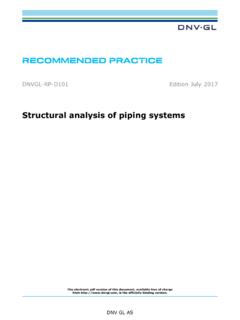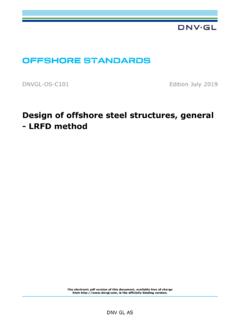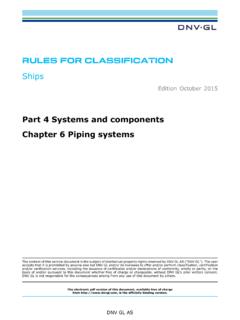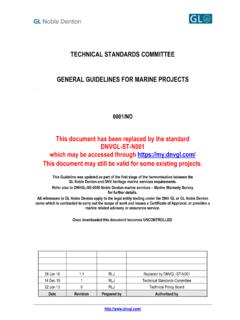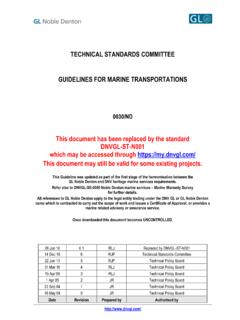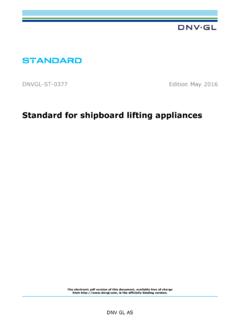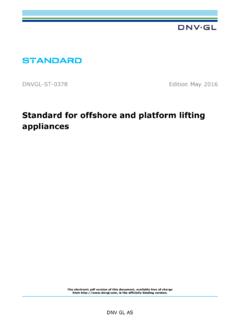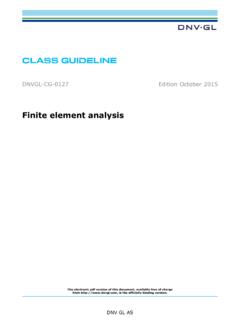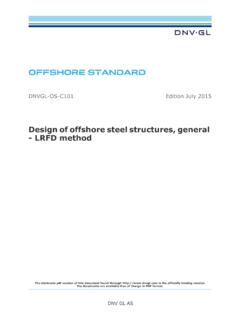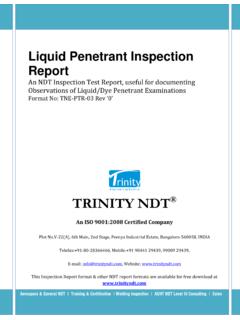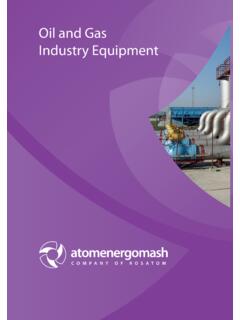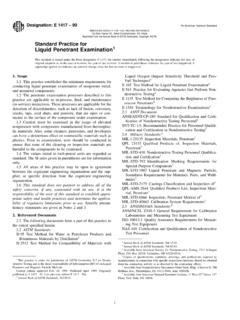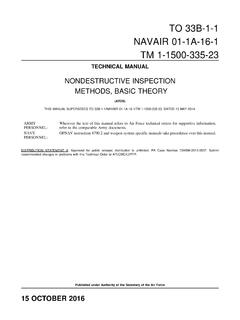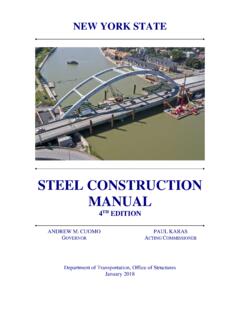Transcription of DNVGL-CG-0051 Non-destructive testing
1 The electronic pdf version of this document, available free of chargefrom , is the officially binding GL ASCLASS GUIDELINEDNVGL-CG-0051 Edition December 2015 Non-destructive testingFOREWORDDNV GL class guidelines contain methods, technical requirements, principles and acceptancecriteria related to classed objects as referred to from the rules. DNV GL AS December 2015 Any comments may be sent by e-mail to any person suffers loss or damage which is proved to have been caused by any negligent act or omission of DNV GL, then DNV GL shallpay compensation to such person for his proved direct loss or damage. However, the compensation shall not exceed an amount equal to tentimes the fee charged for the service in question, provided that the maximum compensation shall never exceed USD 2 this provision "DNV GL" shall mean DNV GL AS, its direct and indirect owners as well as all its affiliates, subsidiaries, directors, officers,employees, agents and any other acting on behalf of DNV - currentClass guideline DNVGL-CG-0051 .
2 Edition December 2015 Page 3 Non-destructive testingDNV GL ASCHANGES CURRENTThis is a new guideline DNVGL-CG-0051 . Edition December 2015 Page 4 Non-destructive testingDNV GL ASCONTENTSC hanges 1 Definitions and 104 115 Personnel Information required prior to 127 Extent of Selection of testing Time of 1411 Final 2 Eddy 163 Personnel Information required (prior to testing ).. 175 Surface 176 Acceptance Evaluation of 2110 3 Magnetic particle 271 Magnetic particle testing on Magnetic particle testing on 37 Section 4 penetrant Personnel Equipment/ testing Compatibility of testing materials with the parts to be Preparation, pre-cleaning and guideline DNVGL-CG-0051 . Edition December 2015 Page 5 Non-destructive testingDNV GL AS6 Acceptance Post cleaning and 4710 5 Radiographic Personnel Classification of radiographic 515 Techniques for making Acceptance 6 Ultrasonic 661 Definitions and 663 Personnel Requirements for 675 Preparation of scanning 716 testing 727 Welds in austenitic stainless and ferritic-austenitic (duplex) 858 Evaluation of imperfections in weld 909 Acceptance criteria, weld Reporting, weld Ultrasonic testing of rolled steel 9212 Ultrasonic testing of 9613 Ultrasonic testing of 98 Section 7 Visual Information required prior to 1033 Requirements for personnel and 1034 testing testing 1046 Preparation of 1047 Evaluation of Visual testing of repaired 105 ContentsClass guideline DNVGL-CG-0051 .
3 Edition December 2015 Page 6 Non-destructive testingDNV GL AS9 Acceptance 10510 A Guidelines regarding ultrasonic testing of thermo mechanicallycontrolled, processed (TMCP) materials and determination of the root area insingle sided 1061 Ultrasonic testing of TMCP Ultrasonic testing and determination of single welded root 1 Class guideline DNVGL-CG-0051 . Edition December 2015 Page 7 Non-destructive testingDNV GL ASSECTION 1 GENERAL1 PreambleThis class guideline applies for Non-destructive testing using the following methods: eddy current testing magnetic particle testing penetrant testing radiographic testing ultrasonic testing visual general, this class guideline shall be adhered to, as far as applicable, when Non-destructive testingis required by the Society. The use of other standards or specifications may, however, be granted if anequivalent testing procedure is ensured or is more fit for the acceptance criteria are defined in the rules, approved drawings, IACS recommendations or otheragreed product standards, these criteria are mandatory.
4 If no acceptance criteria are defined, acceptancecriteria specified in this class guideline may be definitions and requirements stated below may satisfy the need of a written procedure. Where this isnot the case, or where the techniques described in this class guideline are not applicable to the object tobe examined, additional written procedures shall be used and accepted by the Society before the testing iscarried ReferencesThis class guideline incorporates references from other publications. These normative and informativereferences are cited at the appropriate places in the text and constitute provisions of this class edition of the publications shall be used unless otherwise agreed. Other recognised publications maybe used provided it can be shown that they meet or exceed the requirements for the publications Normative referencesTable 1 Normative referencesEN ISO 17636-1 Non-destructive examination of welds Radiographic testing Part 1: X- and gamma-ray techniques with filmEN ISO 17636-2 Non-destructive testing of welds- Radiographic testing - Part 2.
5 X- and gamma-ray techniques with digital detectorsEN ISO 5579 Non-destructive testing - Radiographic testing of metallic materials using film and X- or gamma rays- Basic rulesEN ISO 19232 Non-destructive testing Image quality of radiographsEN ISO 15626 Non-destructive testing of welds - Time- of-flight diffraction technique (TOFD) - Acceptance levelsEN ISO 10863 Non-destructive testing of welds - Ultrasonic testing - Use of time-of-flight diffraction technique(TOFD)EN ISO 17637 Non-destructive examination of fusion welds Visual examinationEN ISO 11699 Non-destructive testing Industrial radiographic filmSection 1 Class guideline DNVGL-CG-0051 . Edition December 2015 Page 8 Non-destructive testingDNV GL ASISO 5580 Non-destructive testing ; Industrial radiographic illuminators; Minimum requirementsISO 17643 Non-destructive examination of welds Eddy Current Examination of welds by complex ISO 15549 Non-destructive testing Eddy Current testing General PrinciplesEN ISO 17635 Non-destructive examination of welds General rules for metallic materialsEN ISO 23277 Non-destructive examination of welds penetrant testing Acceptance ISO 16828 Non-destructive testing - Ultrasonic testing - Time-of-flight diffraction technique as a method fordetection and sizing of discontinuitiesEN ISO 23278 Non-destructive examination of welds Magnetic particle testing - Acceptance levelsEN ISO 5817 Arc-welded joints in steels Guidance on quality levels for imperfections.
6 Welding Fusion-welded joints in steel, nickel, titanium and their alloys (beam welding excluded) Quality levels forimperfectionsEN ISO 6520-1 Welding and allied processes Classification of geometric imperfections in metallic materials Part1: Fusion weldingEN ISO 10042 Welding Arc-welded joints in aluminium and its alloys Quality levels for imperfectionsEN 1330 Non-destructive testing TerminologyISO 15548 Non-destructive testing Equipment for eddy current 17638 Non-destructive testing of welds Magnetic particle testingISO 9934-1 Non-destructive testing Magnetic particle testing Part 1: General principlesEN 10160 Ultrasonic testing of steel and flat product of thickness equal or greater than 6 mm (reflectionmethod)EN ISO 9712 Non-destructive testing Qualification and certification of NDT personnelEN ISO 11666 Non-destructive testing of welds Ultrasonic testing Acceptance levelsISO 23279 Non-destructive testing of welds Ultrasonic testing Characterization of indications in weldsEN ISO 17640 Non-destructive examination of welds Ultrasonic testing Techniques, testing levels, andassessmentEN 12668 Non-destructive testing Characterisation and verification of ultrasonic of ultrasonic equipment;Part 1: Instruments; Part 2: Probes; Part 3: Combined equipmentEN ISO 3059 Non-destructive testing penetrant testing and magnetic particle testing Viewing conditionsEN ISO 3452 Non-destructive testing - penetrant testing Part 1: General principles; Part 2: testing ofpenetrant materials.
7 Part 3: Reference test blocks; Part 4: EquipmentIACS rec. no. 68 Guidelines for Non-destructive examination of hull and machinery steel forgingsEN ISO 12706 Non-destructive testing penetrant testing VocabularyISO 14096-1 Non-destructive testing - Qualification of radiographic film digitalisation systems - Part 1:Definitions, quantitative measurements of image quality parameters, standard reference film andqualitative controlIACS rec. no. 69 Guidelines for Non-destructive examination of marine steel castingsEN ISO 16811 Non-destructive testing - Ultrasonic testing - Sensitivity and range settingSection 1 Class guideline DNVGL-CG-0051 . Edition December 2015 Page 9 Non-destructive testingDNV GL ASEN 10228 Non-destructive testing of steel forgings Part 1: Magnetic particle inspection; - Part 2: Penetranttesting; - Part 3: Ultrasonic testing of ferritic or martensitic steel forgings; - Part 4: Ultrasonictesting of austenitic and austenitic-ferritic stainless steel forgingsEN ISO 13588 Non-destructive testing of welds - Ultrasonic testing - Use of automated phased array technologyISO 4993 Steel castings; Radiographic inspectionSection 1 Class guideline DNVGL-CG-0051 .
8 Edition December 2015 Page 10 Non-destructive testingDNV GL Informative referencesTable 2 Informative referencesASTM A609 /A609M-12 Standard Practice for Castings, Carbon, Low-Alloy, and Martensitic Stainless Steel, UltrasonicExamination ThereofStandard Practice for Castings, Carbon, Low-Alloy, and Martensitic Stainless Steel, UltrasonicExaminationASTM A388 /A388M-11 Standard Practice for Ultrasonic Examination of Steel ForgingsASTM E1316 Standard Terminology for Non-destructive ExaminationsSNT-TC-1 APersonnel Qualification and Certification in Nondestructive Testing3 Definitions and symbolsThe following definitions apply: testing : testing or examination of a material or component in accordance with this class guideline, or astandard, or a specification or a procedure in order to detect, locate, measure and evaluate flaws Defect: One or more flaws whose aggregate size, shape, orientation, location or properties do not meetspecified requirements will be rejected Discontinuity: A lack of continuity or cohesion; an intentional or unintentional interruption in the physicalstructure or configuration of a material or component Flaw: An imperfection or discontinuity that may be detectable by Non-destructive testing will notnecessarily be rejected Indication: Evidence of a discontinuity that requires interpretation to determine its significance False indication: An indication that is interpreted to be caused by a discontinuity at a location where nodiscontinuity exists Non relevant indication: An indication that is caused by a condition or type of discontinuity will not berejected.
9 False indications are non-relevant Imperfections: A departure of a quality characteristic from its intended condition Internal imperfection: Imperfection that is not open to a surface or not directly accessible. Quality level: Fixed limits of imperfections corresponding to the expected quality in a specific object. Thelimits are determined with regard to type of imperfection, their amount and their actual dimensions Acceptance level: Prescribed limits below which a component is accepted Planar discontinuity: Discontinuity having two measurable dimensions Non-planar discontinuity: Discontinuity having three measurable following definitions relevant to MT or PT indications apply: Linear indication: An indication in which the length is at least three times the width Nonlinear indication: An indication of circular or elliptical shape with a length less than three times thewidth Aligned indication: Three or more indications in a line, separated by 2 mm or less edge-to-edge Open indication: An indication visible after removal of the magnetic particles or that can be detected bythe use of contrast dye penetrant Non-open indication.
10 An indication that is not visually detectable after removal of the magnetic particlesor that cannot be detected by the use of contrast dye penetrant Relevant indication: An indication that is caused by a condition or type of discontinuity that requiresevaluation. Only indications which have any dimension greater than mm shall be considered 1 Class guideline DNVGL-CG-0051 . Edition December 2015 Page 11 Non-destructive testingDNV GL AbbreviationsET=eddy current testingACFM=alternating current field measurementMT=magnetic particle testingPT= penetrant testingRT=radiographic testingUT=ultrasonic testingVT=visual testingPAUT=phased ArrayDR=digital RadiographyTOFD=time-of-flight diffractionAUT=automated ultrasonic testingHAZ=heat affected zoneWPS=welding Procedure SpecificationTMCP=thermo mechanically controlled processedNDT= Non-destructive SafetyInternational, national and local safety and environmental protection regulation shall be observed at Personnel qualificationsAll testing shall be carried out by qualified and certified personnel.
